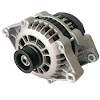Classification of Hydro-electric
power station
The hydro-electric
power plants are mainly classified into several types depending upon the
following factors, namely.
1. Based on the availability of head:
Type of plants Head
A) Low head plants less than 30
meters
b) Medium
head plants 30
to 100 meters
c) High head
plants above
100 meters
2. Based on nature of load/duty:
a) Based
load plants
b) Peak load
plants.
3. Based on the
type of location:
a) Out – door type
b) Indoor type.
c) semi outdoor station.
d) Underground station.
4. Based on the
Hydraulic considerations:
a) Run of river plants
b) Storage plant
c) Pumped storage plant.
5. Based on the
capacity:
a) micro hydel plant less
than 5 M watt
b) Medium capacity plants 5 to 100 M watt
c) High capacity plants 100 to 1000 M watt
d) Super plants above 1000 M watt
6. Based on the
turbine characteristics i.e., specific speed.
a) High specific speed.
b) Medium specific speed
c) low specific speed.
Classification of
Hydro-electric stations Based on Load
The hydro-electric power plants are mainly classified in to two types based on the type of loads, namely.
1. Base load plants
2. Peak load plants
1. Base load plants: A plant supplying base load, which
is more (or) less constant, is known as “Base load plant”. These type of plants
work on almost constant load and its operating efficiency is usually high. Run –off
river plants without pondage and reservoir plants are used as based as base
load plants.
2. Peak load plants: plants which are used to supply the
peak load of the system, then these plants are called “Peak load plants “. Run-off river plants with pondage and pumped
storage plants are used as peak loads. Fig
Peak load plants have large seasonal storage. They store water during off-peak periods and are operated during peak load periods. Load factor or such plants is Low.










0 Comments